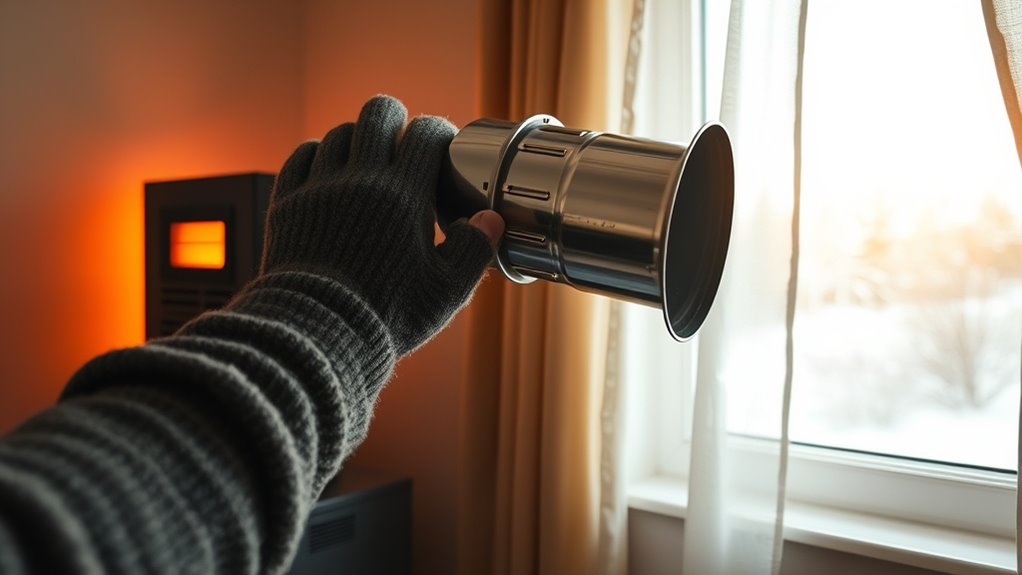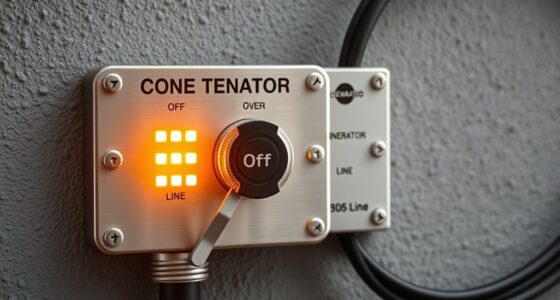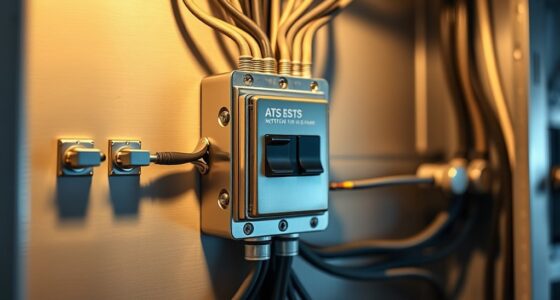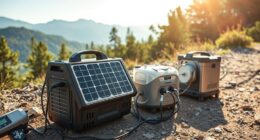When using backup heating, guarantee proper ventilation by opening windows or doors to promote cross-ventilation and allow fresh air in. Keep vents and exhaust fans clear and properly positioned to expel combustion gases safely outside. Regularly check carbon monoxide detectors and maintain your heating equipment to prevent hazardous build-up. Planning quick ventilation breaks and monitoring indoor air quality help keep your home safe. Continue to explore ways to optimize safety and air quality when relying on backup heat.
Key Takeaways
- Ensure proper fresh air intake with vents near the ceiling and floor, following manufacturer and code guidelines.
- Position exhaust fans and vents at least 20 feet from doors, windows, and air intakes to prevent re-entry of gases.
- Use fully ducted outdoor vents or direct outdoor outlets to safely expel combustion gases outside.
- Regularly inspect, maintain, and clean ventilation systems, filters, and exhaust outlets for optimal safety and performance.
- Open windows or doors to promote cross-ventilation during operation or outages, especially when heating with backup sources.
Understanding the Ventilation Needs of Different Backup Heating Systems
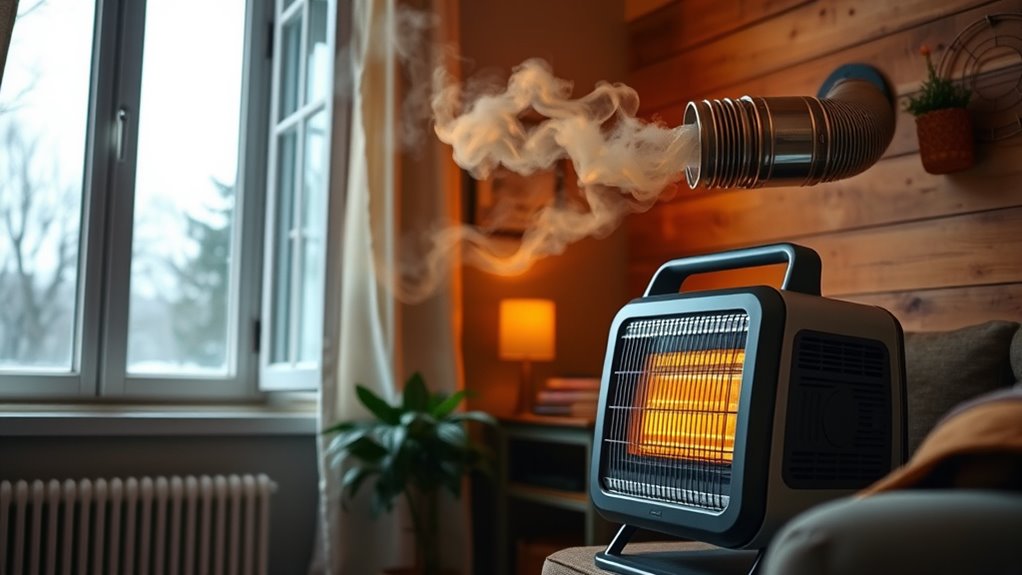
Understanding the ventilation needs of different backup heating systems is essential for safe and efficient operation. For heat pump water heaters (HPWHs), you need enough ambient air supply; poor ventilation makes them rely on less efficient electric resistance backup heating, increasing energy use. In small, enclosed spaces, proper ventilation or ducting is crucial to maintain air temperature and optimize performance. Dual-duct setups, routing intake and exhaust outside, can boost efficiency, especially in areas with varying temperatures. Without adequate ventilation, heat pump efficiency drops, raising energy costs and grid demand. Proper air circulation is vital to prevent overheating and ensure consistent operation. Remember, each HPWH model has specific ventilation requirements, so always consult the manufacturer’s guidelines. Proper ventilation ensures your backup heating runs smoothly, saving energy and maintaining safe indoor conditions. Additionally, understanding fire safety principles related to ventilation can help prevent hazards associated with improper airflow.
Employing Mechanical Ventilation Devices for Safe Indoor Air Quality
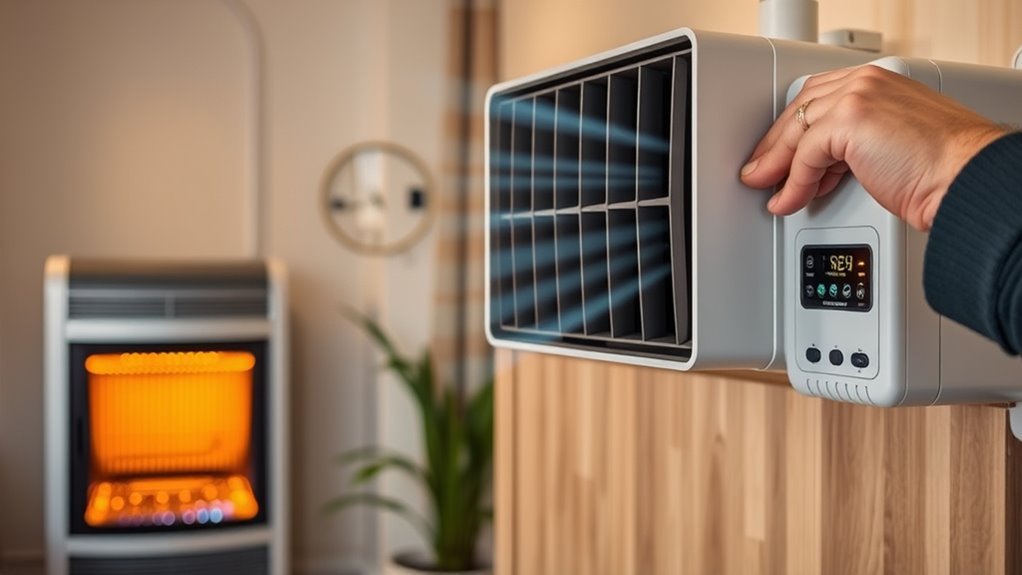
Properly selecting and installing mechanical ventilation devices is essential to maintaining safe indoor air quality when using backup heating systems. You need to choose devices rated for your environment to guarantee compatibility with your heaters. Proper sizing is critical; ventilation should match the backup heater’s capacity to provide adequate fresh air exchange. Install the units where airflow is optimized, avoiding drafts or interference with heater operation. Integrating with existing HVAC systems helps maintain continuous air quality. Use filters like HEPA or equivalent to reduce particulate contaminants and improve air cleanliness. Regular maintenance—including monthly inspections, filter replacements, and lubrication—keeps the system functioning efficiently. Ensure your devices have backup power and alarms to alert you to failures, especially during outages, ensuring safe indoor conditions at all times.
Using Natural Ventilation Techniques During Power Outages
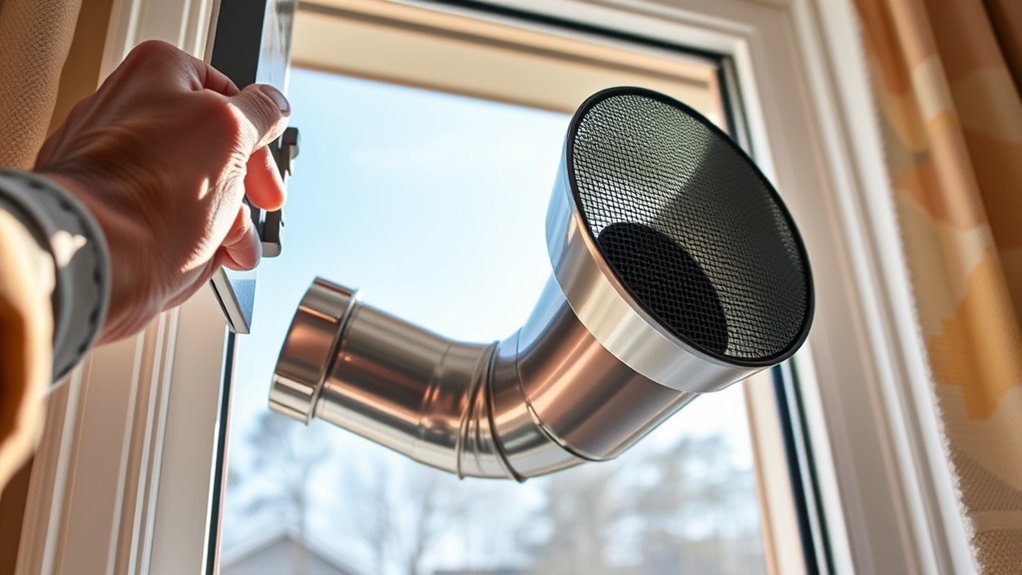
During power outages, natural ventilation becomes a vital way to keep indoor air fresh and comfortable. You can create effective airflow by opening windows on opposite sides of your home, establishing a cross-ventilation route that allows cooler outdoor air to enter and warmer indoor air to exit. Use wind to your advantage by opening windows when the breeze aligns with your ventilation path. During cooler periods like evenings or cloudy days, avoid opening windows during hot weather to prevent drawing in heat. Enhance airflow by opening interior doors and passageways connecting the ventilated windows. For vertical airflow, utilize the stack effect by opening vents at different heights—cool air in low, warm air out high. This approach helps maintain fresh, well-circulated indoor air during power outages. Additionally, understanding the importance of air exchange rates can help you optimize ventilation efficiency and indoor air quality. Implementing natural ventilation techniques can also reduce reliance on mechanical systems and improve overall home comfort during emergencies.
Ensuring Proper Placement and Use of Exhaust Fans and Vents
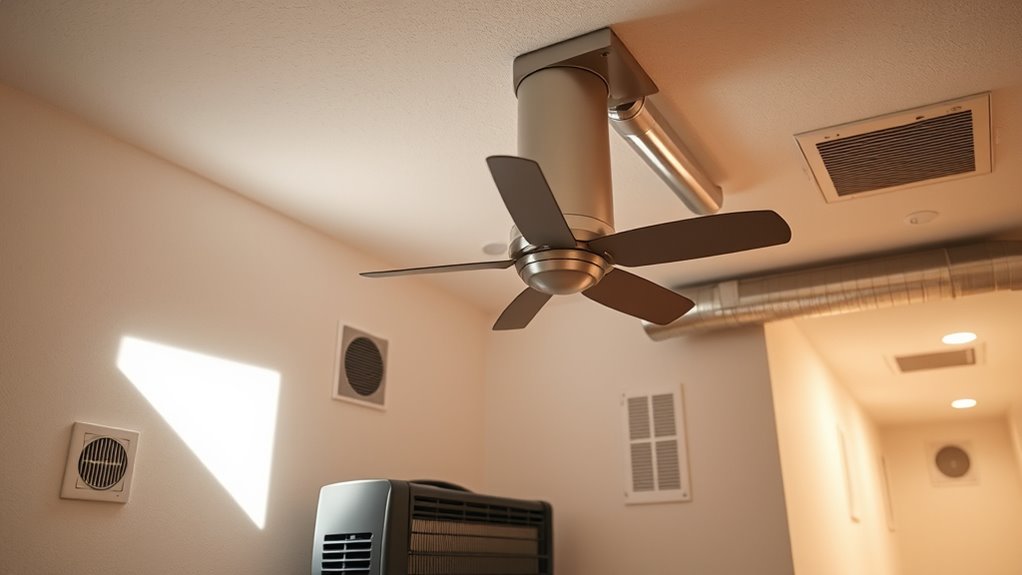
You need to place exhaust fans and vents at least 20 feet away from doors, windows, and intakes to prevent dangerous gases from re-entering your home. Position them so fumes are directed away from your house and nearby occupied areas, ensuring proper airflow. Regularly check that vents are open, unobstructed, and installed according to local codes to keep your ventilation effective and safe. Proper ventilation setup is essential for maintaining a safe environment when using backup heating systems. Additionally, understanding compliance with safety standards can help in addressing any concerns or issues that may arise during heating emergencies. Awareness of security zone info can also improve your overall safety planning in emergency situations.
Optimal Exhaust Fan Placement
Strategic placement of exhaust fans is essential for safe and effective ventilation when using backup heating systems. You should position fans near the heat source or combustion appliance to direct pollutants and combustion byproducts outside, preventing indoor air contamination. Keep fans a safe distance from the heater to avoid overheating. Place fans to extract air from the warmest or noisiest areas created by backup heating, maximizing removal efficiency. For attic or rooftop units, ensure vents are roof-mounted or sidewall-mounted, directing exhaust away from intake vents and windows. Avoid installing fans under eaves or soffits, where discharged air might re-enter the building. Proper placement guarantees pollutants are expelled efficiently without compromising indoor air quality or safety. Additionally, understanding ventilation best practices can provide insights into how technology influences environmental safety measures. It’s also beneficial to consult with HVAC professionals to optimize exhaust fan placement for your specific setup.
Proper Ventilation Pathways
Proper placement of exhaust fans and vents is essential to ensuring effective ventilation when using backup heating systems. You need to position vents to facilitate direct airflow from heat sources to the outside, avoiding recirculation indoors. Use dedicated pathways that are as short and direct as possible to reduce resistance and pollutant buildup. Here’s an example of ideal ventilation pathways:
| Pathway Type | Description |
|---|---|
| Ducted Exhaust Fans | Fully ducted to outdoors, preventing indoor contamination |
| Direct Outdoor Vents | Open directly outside, especially for combustion appliances |
Ensure each vent and fan is properly sealed and positioned to maintain airflow efficiency, prevent backdrafts, and comply with building codes. Proper pathways guarantee safe exhaust and fresh air intake, protecting indoor air quality. Track development techniques can help optimize these pathways for maximum efficiency. Properly designed pathways minimize pollutant buildup and ensure safe operation of backup heating units.
Installing and Maintaining Carbon Monoxide Detectors and Sensors
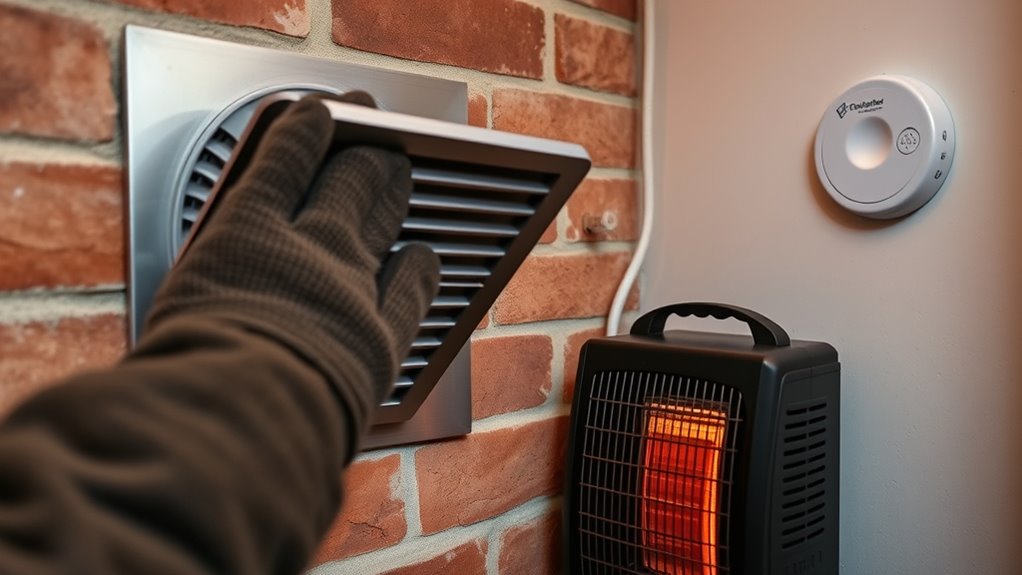
Installing and maintaining carbon monoxide (CO) detectors is essential for guaranteeing home safety, especially in residences with fuel-burning appliances or attached garages. To maximize protection, follow these key steps:
- Place detectors properly—on walls about 5 feet above the floor or on ceilings, avoiding areas near fuel-burning appliances or humid zones. Proper placement ensures accurate detection of CO buildup in living spaces.
- Ensure coverage—install at least one detector on each level, including basements, inside, and outside sleeping areas. This comprehensive coverage helps provide early warnings throughout the home.
- Choose the right type—use UL-listed, hardwired models with battery backup and interconnected detectors for thorough safety. Interconnected detectors allow alarms to sound simultaneously in multiple areas, increasing awareness.
- Maintain regularly—test monthly, replace batteries yearly, and swap out detectors every 5 to 7 years to keep sensors accurate. Regular maintenance preserves the detector’s reliability and lifespan.
- Regularly review glycolic acid products and other skincare routines to ensure overall home safety and health, as proper maintenance extends beyond just detectors. Additionally, understanding home safety technologies can further enhance your safety measures.
Following these guidelines helps guarantee early detection and keeps your home safe from CO risks.
Safely Operating Fuel-Burning Heaters and Managing Ventilation Risks
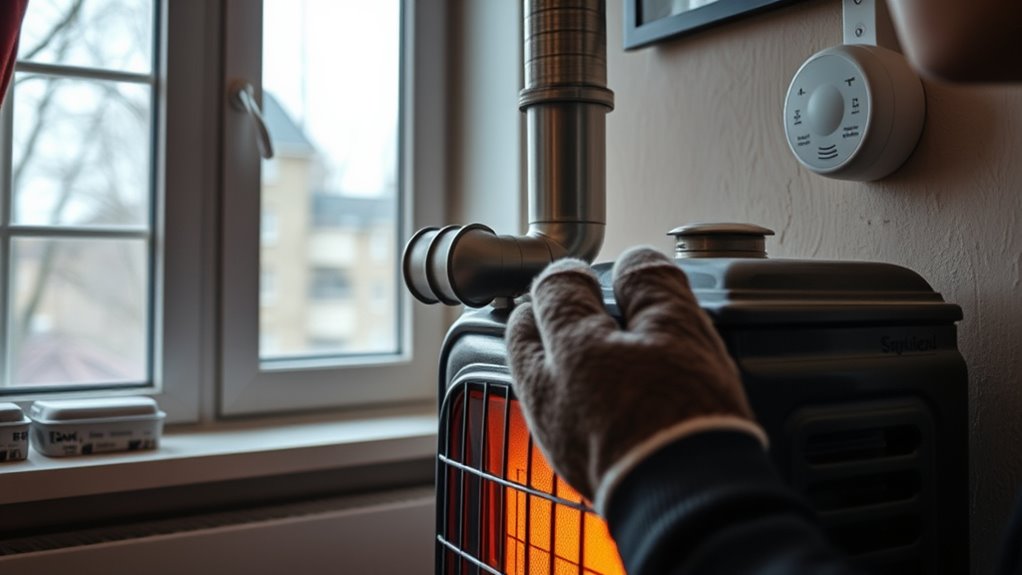
Operating fuel-burning heaters safely requires ensuring adequate ventilation to supply enough fresh air for combustion and prevent dangerous buildup of gases. You need to match the fresh air supply with the heater’s air consumption—typically 15–20 m³/hr during initial heating or 10 m³/hr for continuous operation of certain infrared oil heaters. Combustion air openings should provide at least 2 square inches of net free area per 1,000 BTU/hr of input. Strategic placement of openings—near the ceiling and floor—helps promote air circulation and maintain efficiency. Properly venting exhaust gases outdoors and maintaining clearances around appliances are essential. Follow applicable codes to ensure safe operation and avoid risks like incomplete combustion or toxic gas buildup. Understanding the importance of proper ventilation can help prevent hazardous conditions during heater use. Additionally, ensuring proper air exchange rate in your space enhances overall safety and effectiveness, especially when dealing with vetted global standards for indoor air quality. Maintaining a consistent ventilation system can further mitigate the risk of harmful gas accumulation and promote healthier indoor conditions.
Practical Tips for Emergency Ventilation and Air Quality Management

When using backup heating systems, it’s important to have a clear plan for emergency ventilation and maintaining good indoor air quality. Here are practical tips to help you manage this effectively:
- Ensure ventilation openings like windows and vents stay unobstructed during heating.
- Use cross-ventilation whenever possible to replace indoor pollutants with fresh air.
- Designate specific rooms with open vents for heating to better control airflow.
- Use portable fans or other temporary aids to boost air exchange if natural ventilation is limited.
- Regularly check and maintain your air quality monitors to detect and address any indoor pollution issues promptly.
- Be aware that trust issues may arise if ventilation is inadequate, so maintaining open communication about air quality concerns is beneficial. Additionally, keep carbon monoxide detectors active and test them regularly. Avoid prolonged use of backup heaters, monitor humidity levels, and plan quick ventilation breaks by opening doors or windows. These steps help keep your indoor air safe and healthy.
Frequently Asked Questions
How Often Should I Inspect My Backup Heater’s Venting System?
You should inspect your backup heater’s venting system at least once a year, ideally before the heating season begins. If you live in a harsh climate or use the heater frequently, consider semi-annual inspections. Check for corrosion, blockages, leaks, and make certain vent terminals are clear. Regular inspections help prevent dangerous buildup of gases, improve efficiency, and keep your home safe. Always follow manufacturer recommendations for specific maintenance intervals.
Can I Use Window Fans to Improve Ventilation During Outages?
Yes, you can use window fans to improve ventilation during outages. Position them correctly to pull in fresh air or exhaust stale indoor air, helping maintain good airflow. Use both intake and exhaust fans for balanced ventilation, but avoid placing them near sources of odors or contaminants. Make certain they seal well in the window to prevent drafts. Remember, they can’t remove hazardous gases like carbon monoxide, so use detectors and additional safety measures.
What Are Signs of Poor Indoor Air Quality From Backup Heating?
Think of your home as a breathing creature; when it struggles, signs reveal themselves. You notice irritation in your eyes, nose, and throat, along with headaches, dizziness, or fatigue—like your house’s cry for fresh air. Lingering musty smells, dust on vents, or uneven temperatures signal poor air quality. If odors or visible mold appear, your home’s lungs are compromised. Recognizing these signs helps you breathe easier and restore balance.
Are There Portable Ventilation Devices Suitable for Emergency Use?
Yes, there are portable ventilation devices suitable for emergency use. You can choose emergency ventilators like the COVID Ventor system, which offers multiple modes and adjustable settings. Portable, battery-operated units with safety features, durability, and lightweight design are ideal for quick deployment. These devices help guarantee proper airflow, reduce risks of poor air quality, and are suitable for various environments, including disaster sites, homes, or field hospitals.
How Does Home Airtightness Affect Backup Heating Ventilation Strategies?
Think of your home as a sealed treasure chest; airtightness keeps valuables safe but traps moisture and pollutants inside. This means your backup heating needs a carefully choreographed dance with ventilation strategies. You should install controlled systems like heat recovery ventilators that act as gentle breathers, exchanging stale air for fresh, all while conserving warmth. Properly balanced, your home stays cozy, safe, and healthy without letting the cold or contaminants sneak in.
Conclusion
Remember, safeguarding your home’s air is like tending a delicate garden—regularly check, maintain, and listen to your ventilation system’s heartbeat. When backup heating kicks in, guarantee fresh air flows like a gentle river, washing away fumes and hazards. By staying vigilant and proactive, you turn your space into a fortress of fresh, safe air, allowing you to breathe easy even when the power’s out. Keep the air flowing, and peace of mind will follow.

